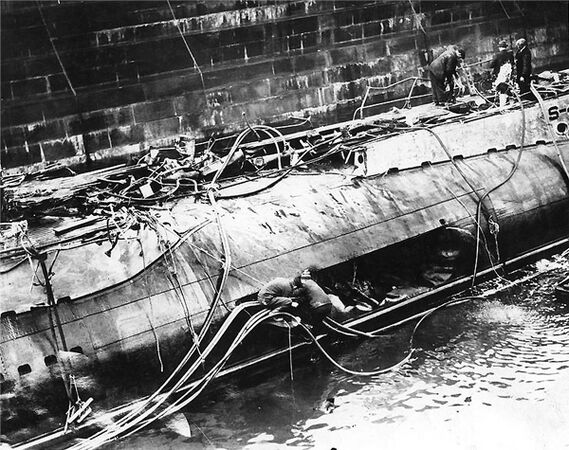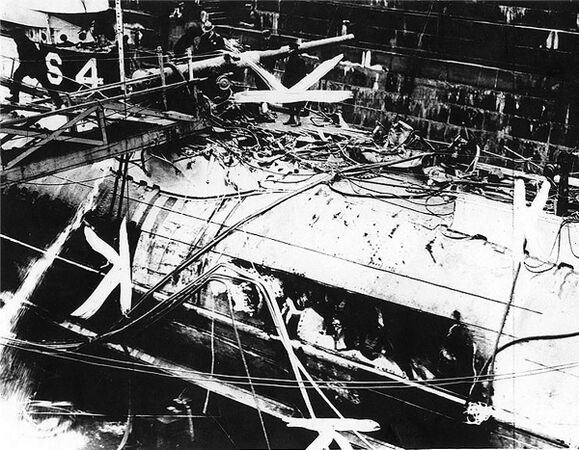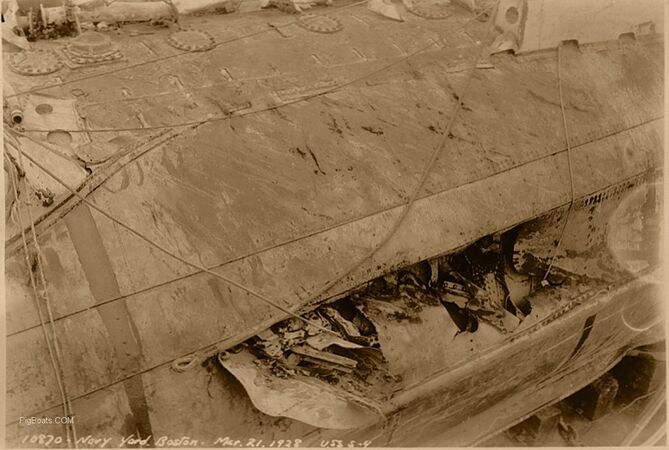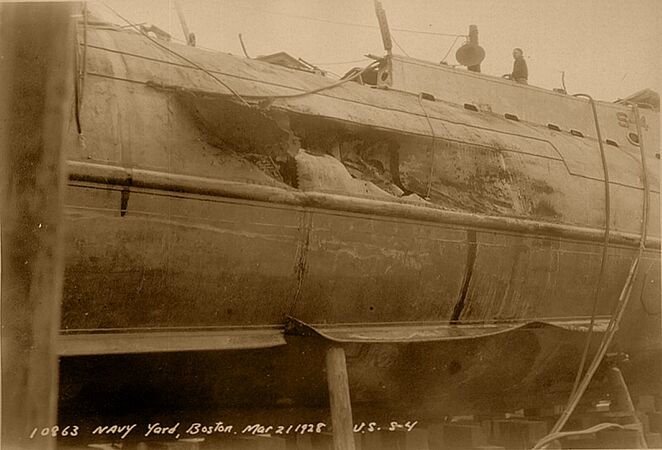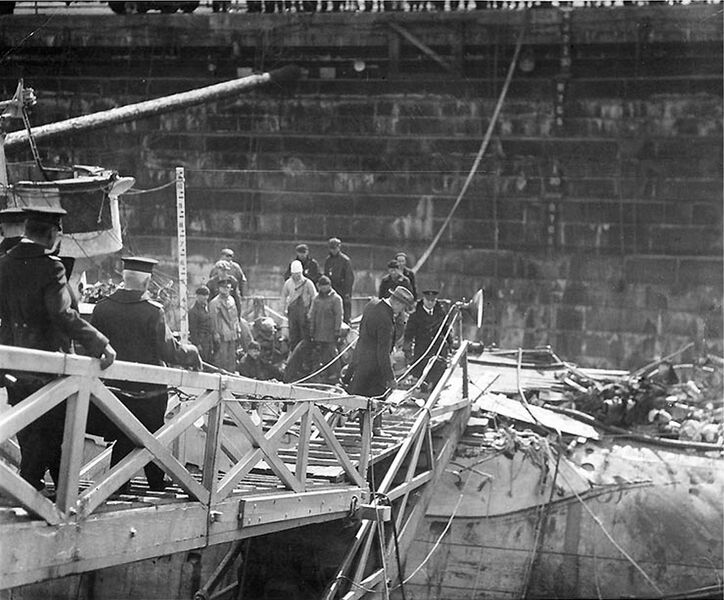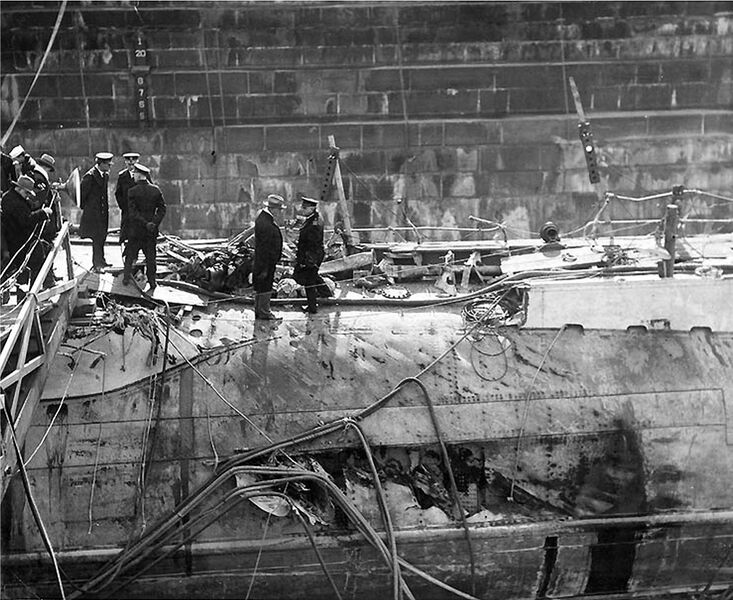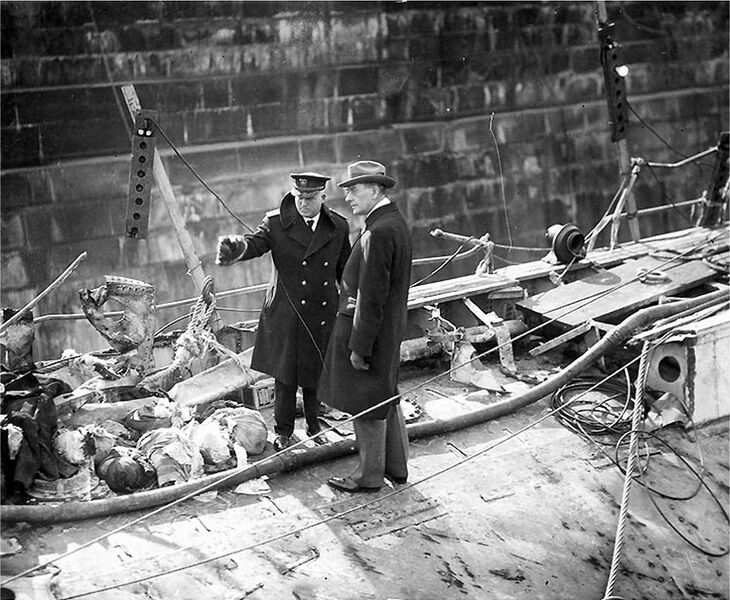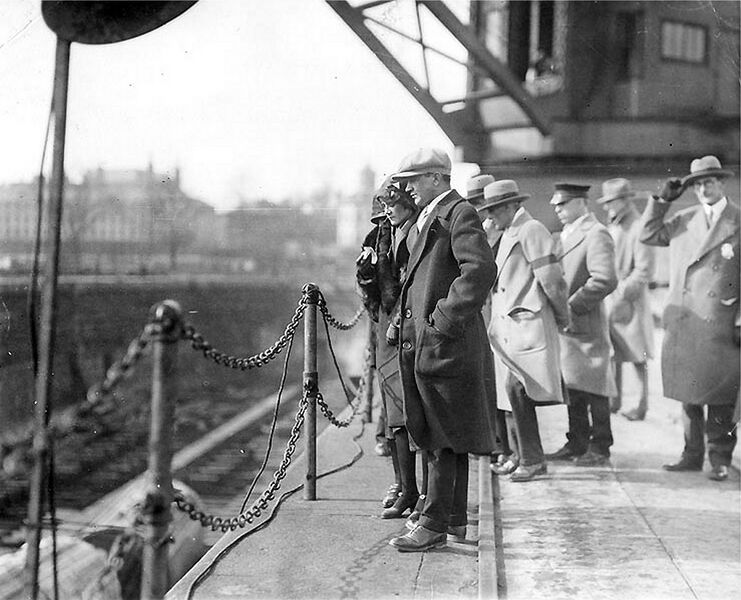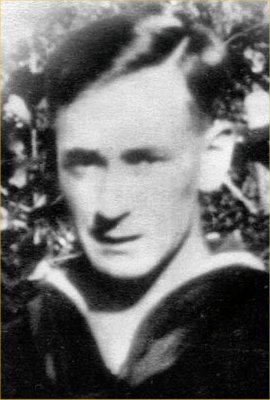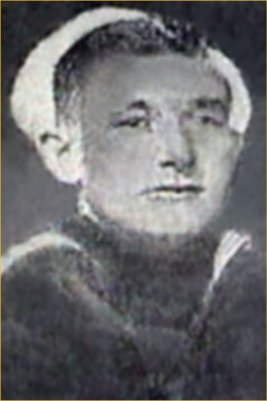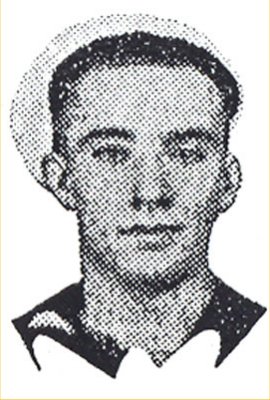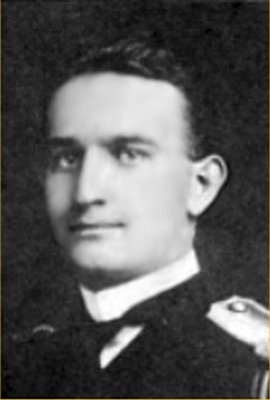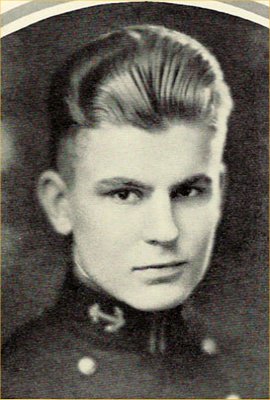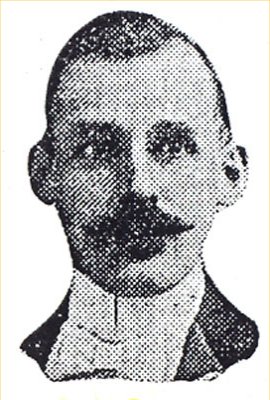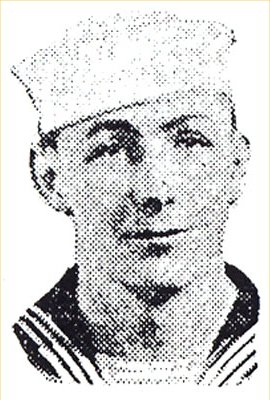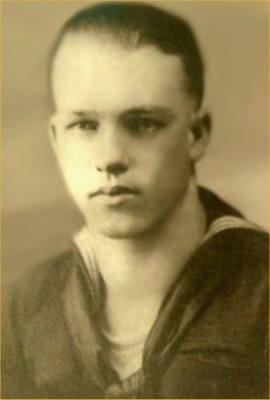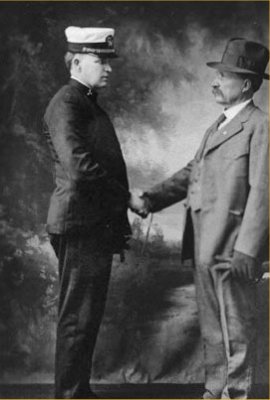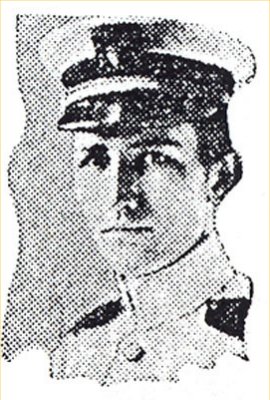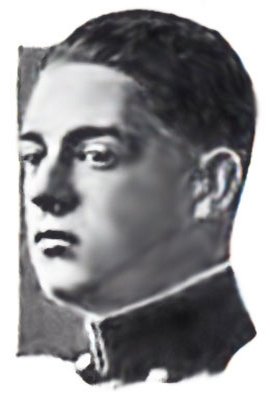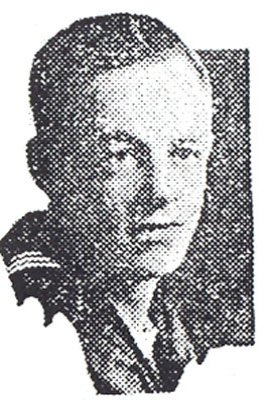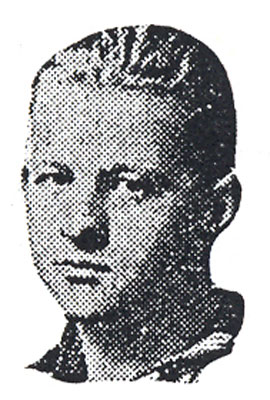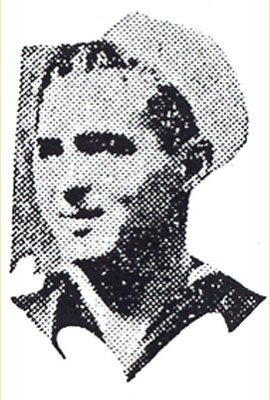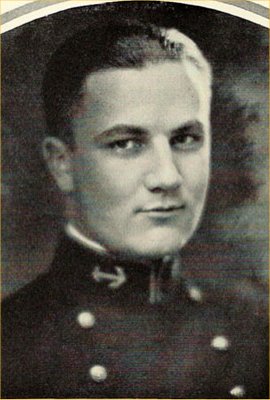S-4 salvage: Difference between revisions
Pbcjohnston (talk | contribs) Added captions |
Pbcjohnston (talk | contribs) Added captions |
||
| Line 119: | Line 119: | ||
</center> | </center> | ||
<div style="text-align: justify;"><span style="color:#00008B">A series of four photos show Secretary of the Navy Curtis D. Wilbur (wearing the fedora hat and long coat) at the Boston Navy Yard on March 20, 1928 to inspect the wreck of the S-4. In photo #1 he is talking to Captain Ernest J. King, who commanded the Salvage Force. On the far left is RADM Philip Andrews, Commandant of the Boston Navy Yard, and on the right is Lieutenant Henry Hartley, a salvage expert. King would go on to five star Fleet Admiral rank and would serve President Franklin Roosevelt as Chief of Naval Operations during WWII. | <div style="text-align: justify;"><span style="color:#00008B">A series of four photos show Secretary of the Navy Curtis D. Wilbur (wearing the fedora hat and long coat) at the Boston Navy Yard on March 20, 1928 to inspect the wreck of the S-4. In photo #1 he is talking to Captain Ernest J. King, who commanded the Salvage Force. On the far left is RADM Philip Andrews, Commandant of the Boston Navy Yard, and on the right is Lieutenant Henry Hartley, a salvage expert. King would go on to five star Fleet Admiral rank and would serve President Franklin Roosevelt as Chief of Naval Operations during WWII. | ||
<small>U.S. Navy photos.</small> | |||
[[File:Red bar sub new.jpg]] | |||
<center> | |||
<gallery mode="packed" widths="500px" heights="400px"> | |||
File:S-4 widow 1.jpg | |||
File:S-4 widow 2.jpg | |||
</gallery> | |||
</center> | |||
<div style="text-align: justify;"><span style="color:#00008B">In conjunction with the Secretary of the Navy's visit, a family member, identified as a Miss Fennell, sister of Machinist's Mate 1st Class John Joseph Fennell, who lost his life when S-4 was sunk, watches as the submarine rests in dry dock at the Boston Navy Yard, Charlestown, Massachusetts, March 20, 1928. Other family members can be seen in this photo also. Note the arm bands. | |||
<small>U.S. Navy photos.</small> | <small>U.S. Navy photos.</small> | ||
| Line 138: | Line 150: | ||
[[File:Red bar sub new.jpg]] | [[File:Red bar sub new.jpg]] | ||
[[File:S-4 | [[File:S-4 remove torp.jpg|left|500px]] | ||
<div style="text-align: justify;"><span style="color:#00008B"> | <div style="text-align: justify;"><span style="color:#00008B">A Mk 10 torpedo is removed from the S-4. The weapon was pushed by hand out of the torpedo tube, where a crane gingerly picked up the weapon and moved it to the pier. How many weapons the S-4 was carrying on her final voyage is not known. | ||
<small> | <small>U.S. Navy photo.</small> | ||
[[File:Red bar sub new.jpg]] | [[File:Red bar sub new.jpg]] | ||
[[File:S-4 | [[File:S-4 battery room damage 1.jpg|left|500px]] | ||
<div style="text-align: justify;"><span style="color:#00008B"> | <div style="text-align: justify;"><span style="color:#00008B">Interior of the Battery Room, looking forward and to starboard, March 23, 1928. The irregular object running the length of the compartment, just above the lockers on the right (port) side, is the collapsed ventilator duct through which water entered the Control Room. The curtain to the C.O.'s bunk was drawn into this duct, which clogged the valve on the after side of the bulkhead, preventing it from closing. This allowed flooding of the control room, forcing the crew to abandon it aft to the engine room. The white object running at an angle down and to the left is the support for the center two rows of bunks. | ||
S-4 flooded through a hole, made by Paulding's bow, in the forward starboard side of the Battery Room. | |||
<small> | <small>U.S. Navy photo.</small> | ||
[[File:Red bar sub new.jpg]] | [[File:Red bar sub new.jpg]] | ||
[[File:S-4 | [[File:S-4 battery room damage 2.jpg|left|500px]] | ||
<div style="text-align: justify;"><span style="color:#00008B"> | <div style="text-align: justify;"><span style="color:#00008B">In this closeup view of the starboard side of the battery room shows the pressure hull penetration caused by the Paulding's bow. A piece of her forefoot can be seen protruding into the interior. The crew made an attempt to stem the flooding by packing articles of clothing into the breach. | ||
<small> | <small>U.S. Navy photo.</small> | ||
[[File:Red bar sub new.jpg]] | [[File:Red bar sub new.jpg]] | ||
[[File:S-4 | [[File:S-4 torp room door 1.jpg|left|500px]] | ||
<div style="text-align: justify;"><span style="color:#00008B"> | <div style="text-align: justify;"><span style="color:#00008B">This view from inside S-4's torpedo room after the boat had been placed in drydock. It was in this compartment that six men died a lingering death. This view looks aft at the door into the battery room, showing the door tightly dogged. The door itself was tight, but the glass deadlight window leaked, as is shown by the rubber sheet held in place by a pinch bar and wooden wedges, placed there by the trapped men. It was a classic work of naval damage control by desperate men. | ||
The six men in this compartment were; | |||
Lieutenant Graham N. Fitch<br> | |||
Torpedoman's Mate Russell A. Crabb<br> | |||
Seaman Joseph L. Stevens<br> | |||
Seaman George Pelnar<br> | |||
Torpedoman's Mate Roger L. Short<br> | |||
Torpedoman's Mate Frank Snizek | |||
As the trapped men used the last of available oxygen in the sub's torpedo room, a diver placed his helmeted ear to the side of the vessel and received this Morse-coded message, “Is … there … any … hope?” Unfortunately, the ultimate answer was "no". All six men died. | |||
As a result of these first sinkings the doors used in submarines were redesigned smaller and heavier and existing boats were retrofitted with these over time. New submarines were designed with the smaller doors. | |||
<small>U.S. Navy photo.</small> | |||
[[File:Red bar sub new.jpg]] | [[File:Red bar sub new.jpg]] | ||
[[File:S-4 note.jpg|left|500px]] | [[File:S-4 note.jpg|left|500px]] | ||
<div style="text-align: justify;"><span style="color:#00008B"> | <div style="text-align: justify;"><span style="color:#00008B">A letter written by Torpedoman Roger Leslie Short when he realized that he may not survive the sinking of the S-4. | ||
<small> | The letter says: ''In case of my death please send entire contents of box to my mother Mrs. (unreadable) Short 804 (unreadable) Spring St. Booneville, Mississippi. By Roger L. Short U.S.N.'' | ||
<small>Courtesy of the Boston Public Library, Leslie Jones Collection.</small> | |||
[[File:Red bar sub new.jpg]] | [[File:Red bar sub new.jpg]] | ||
[[File:S-4 pelnar note.jpg|left|500px]] | [[File:S-4 pelnar note.jpg|left|500px]] | ||
<div style="text-align: justify;"><span style="color:#00008B"> | <div style="text-align: justify;"><span style="color:#00008B">Seaman George Pelnar left this message on where to send his body when and if it was recovered. It says: ''My body to Pelnar 5609 S. 19th St., Omaha, Neb.'' | ||
Seaman George Pelnar had only been aboard for 21 days at the time of sinking. | |||
<small> | <small>Courtesy of the Boston Public Library, Leslie Jones Collection.</small> | ||
[[File:Red bar sub new.jpg]] | [[File:Red bar sub new.jpg]] | ||
| Line 226: | Line 243: | ||
William Dempsey / | William Dempsey / | ||
Robert William Diefenbach / | Robert William Diefenbach / | ||
John Joseph | John Joseph Fennell / | ||
Donald Fred Goering / | Donald Fred Goering / | ||
Peder Haaland / | Peder Haaland / | ||
Revision as of 12:42, 7 September 2023
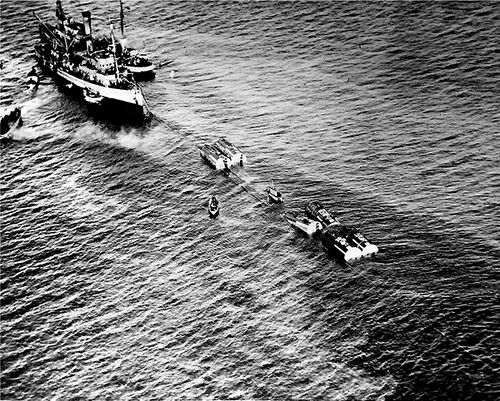
The salvage operation went remarkably well, all things considered. The Navy had learned a lot about open ocean salvage during the S-51 operation two years prior. Those lessons greatly sped the S-4 operation, and she was off the bottom in a little over three months, as opposed to the 9½ months for the S-51.
Please see the Jim Christley article at this link for the story of the S-4.
U.S. Navy photo.
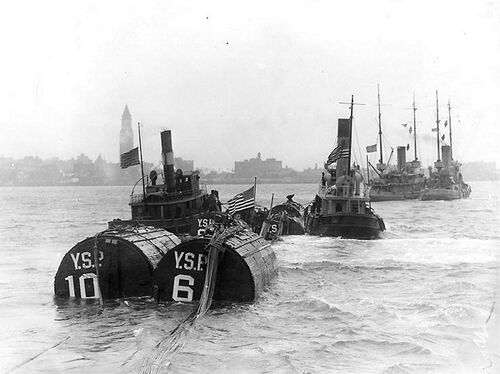
U.S. Navy photo.
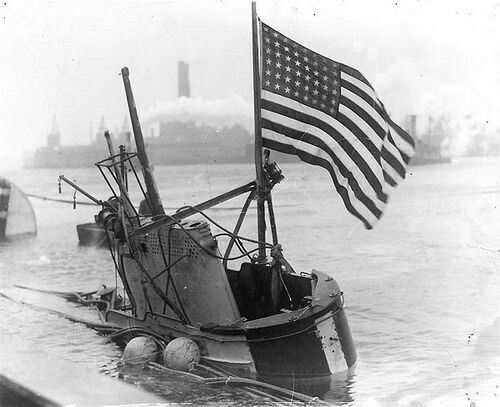
U.S. Navy photo.
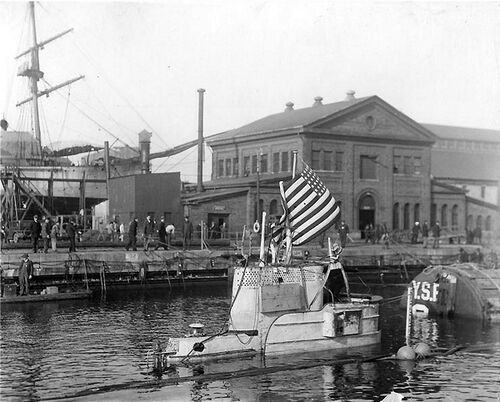
U.S. Navy photo.

U.S. Navy photo.
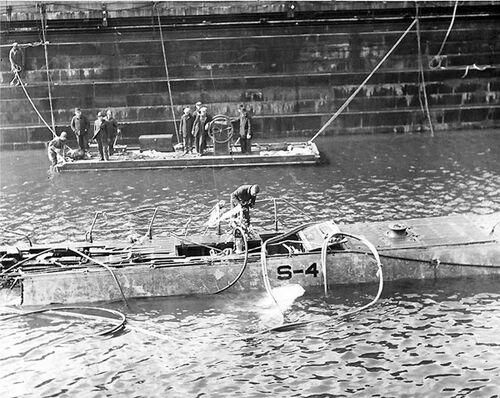
U.S. Navy photo.
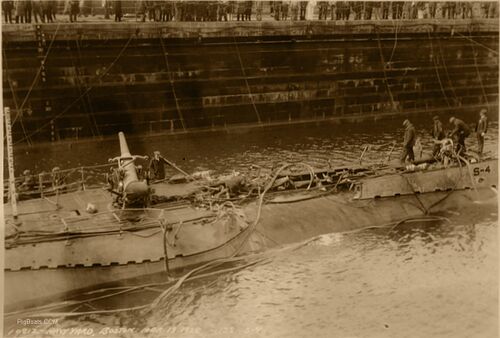
Image provided courtesy of the Stephen B. Luce Library, SUNY Maritime College, Papers of John S. Baylis.
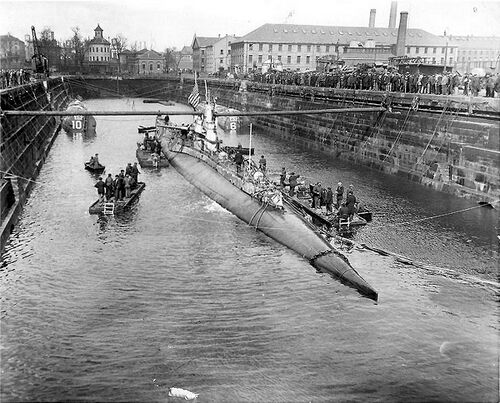
U.S. Navy photo
Image provided courtesy of the Stephen B. Luce Library, SUNY Maritime College, Papers of John S. Baylis via Joe Williams.

mage provided courtesy of the Stephen B. Luce Library, SUNY Maritime College, Papers of John S. Baylis via Joe Williams.
-
U.S. Navy photo.
-
U.S. Navy photo.
-
Image provided courtesy of the Stephen B. Luce Library, SUNY Maritime College, Papers of John S. Baylis via Joe Williams.
-
Image provided courtesy of the Stephen B. Luce Library, SUNY Maritime College, Papers of John S. Baylis via Joe Williams.
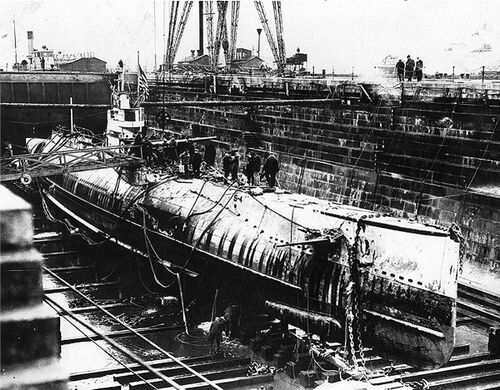
The long sausage looking object on the hull below the waterline beneath the bow planes is a MV sonar, a replacement for the earlier Y-tube mounted on the main deck forward. It was a line array of 12 microphones and was electronically steered. A duplicate array was on the port side.
U.S. Navy photo.
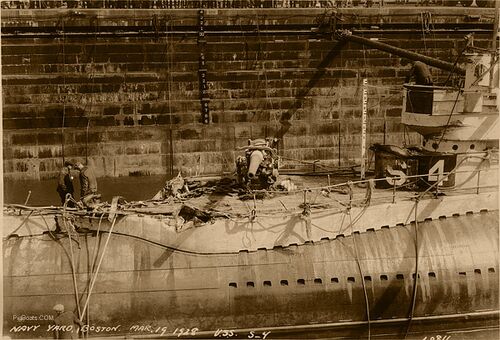
Image provided courtesy of the Stephen B. Luce Library, SUNY Maritime College, Papers of John S. Baylis via Joe Williams.
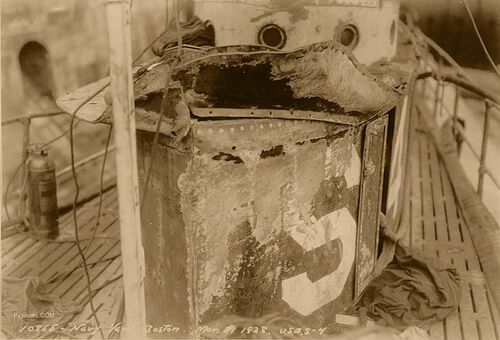
Image provided courtesy of the Stephen B. Luce Library, SUNY Maritime College, Papers of John S. Baylis via Joe Williams.
U.S. Navy photos.
U.S. Navy photos.
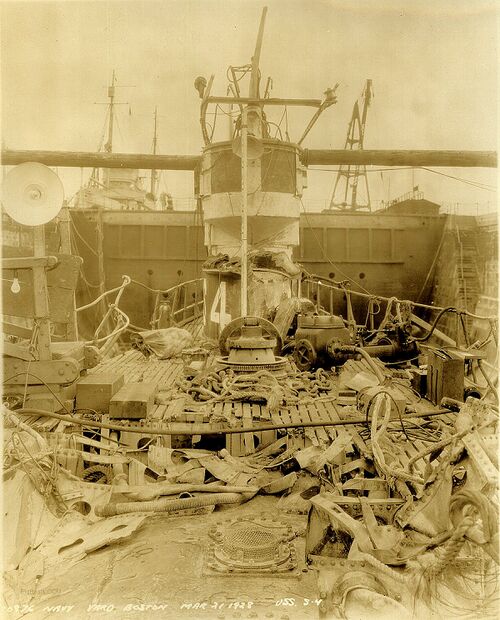
Image provided courtesy of the Stephen B. Luce Library, SUNY Maritime College, Papers of John S. Baylis via Joe Williams.
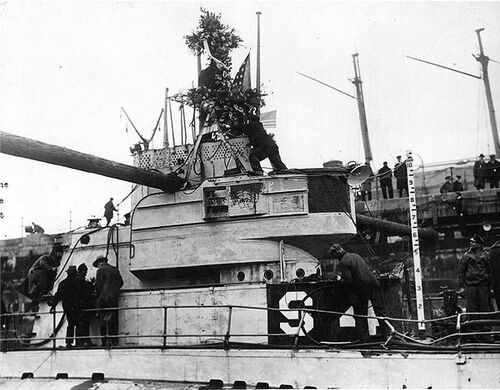
U.S. Navy photo.
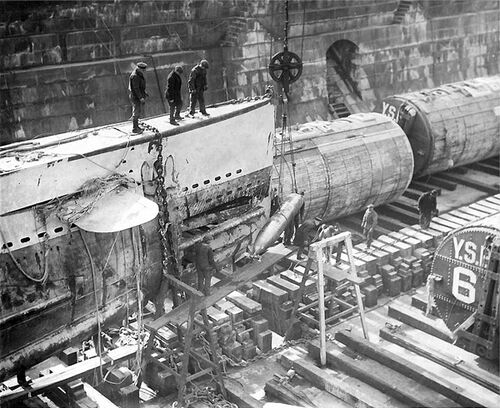
U.S. Navy photo.

S-4 flooded through a hole, made by Paulding's bow, in the forward starboard side of the Battery Room.
U.S. Navy photo.
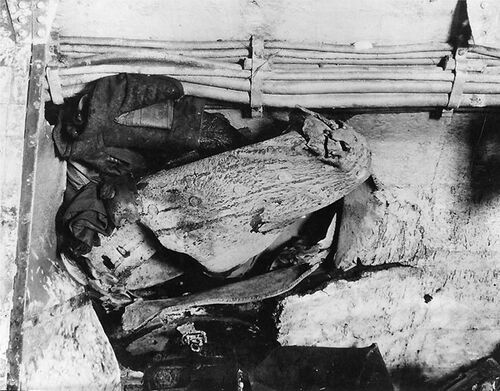
U.S. Navy photo.
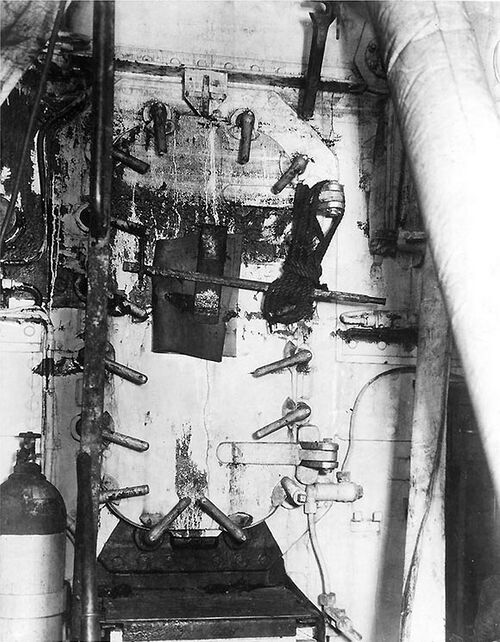
The six men in this compartment were;
Lieutenant Graham N. Fitch
Torpedoman's Mate Russell A. Crabb
Seaman Joseph L. Stevens
Seaman George Pelnar
Torpedoman's Mate Roger L. Short
Torpedoman's Mate Frank Snizek
As the trapped men used the last of available oxygen in the sub's torpedo room, a diver placed his helmeted ear to the side of the vessel and received this Morse-coded message, “Is … there … any … hope?” Unfortunately, the ultimate answer was "no". All six men died.
As a result of these first sinkings the doors used in submarines were redesigned smaller and heavier and existing boats were retrofitted with these over time. New submarines were designed with the smaller doors.
U.S. Navy photo.
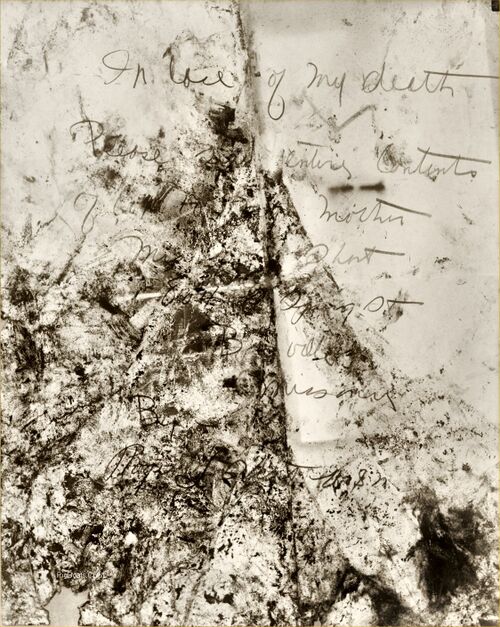
The letter says: In case of my death please send entire contents of box to my mother Mrs. (unreadable) Short 804 (unreadable) Spring St. Booneville, Mississippi. By Roger L. Short U.S.N.
Courtesy of the Boston Public Library, Leslie Jones Collection.
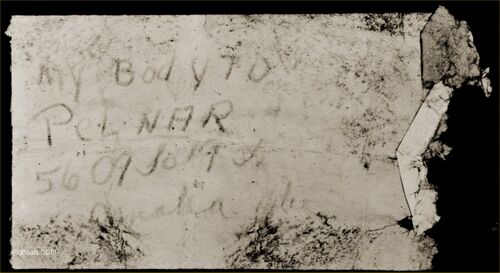
Seaman George Pelnar had only been aboard for 21 days at the time of sinking.
Courtesy of the Boston Public Library, Leslie Jones Collection.
-
Walter Bishop
-
Henry Handy Brown
-
Charles Frederick Burrell
-
Charles Beresford Calcott
-
William Franklin Callaway
-
Graham Newell Fitch
-
Charles A. Ford / Civilian
-
Daniel Michael Gavin
-
Dewey Victor Haney
-
Aaron A. Hodges w/Uncle
-
Roy Kehlor Jones
-
Joseph Alfred McGinley
-
John Jospeh Powers
-
Roger Leslie Short
-
Frank Snizek
-
Joseph William Sternman
-
Joseph Leighton Stevens
-
Donald Weller
Other lost Crew with no photo:
Clarence Ferdinand Bethke / Earl Welsh Boone / Elmer Lyfford Cash / Russell Archibald Crabb / William Dempsey / Robert William Diefenbach / John Joseph Fennell / Donald Fred Goering / Peder Haaland / Buster Harris / Arthur Frederick Hodges / Paul Richard Kempfer / J. H. Long / Fred Henry O'Shields / George Pelnar / Rudolf James Rose / Alfred Eugene Seaton / Carl Bernice Strange / Mariano Tedar / Carl Harold Thompson / Walter Ross Tolson / James Johnson White
Photos courtesy of the On Eternal Patrol website
Page created by:
Ric Hedman & David Johnston
1999 - 2023 - PigBoats.COM©
Mountlake Terrace, WA, Norfolk, VA
webmaster at pigboats dot com

